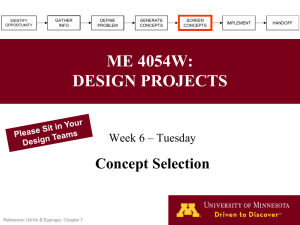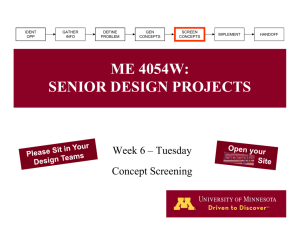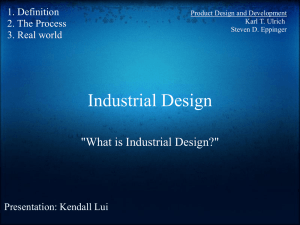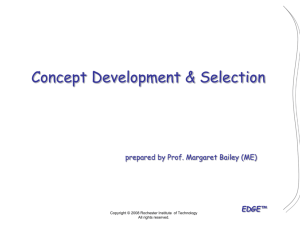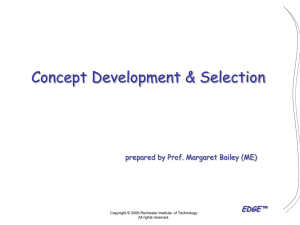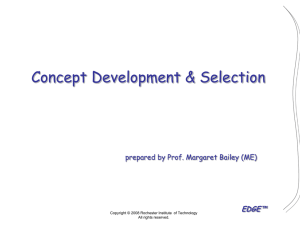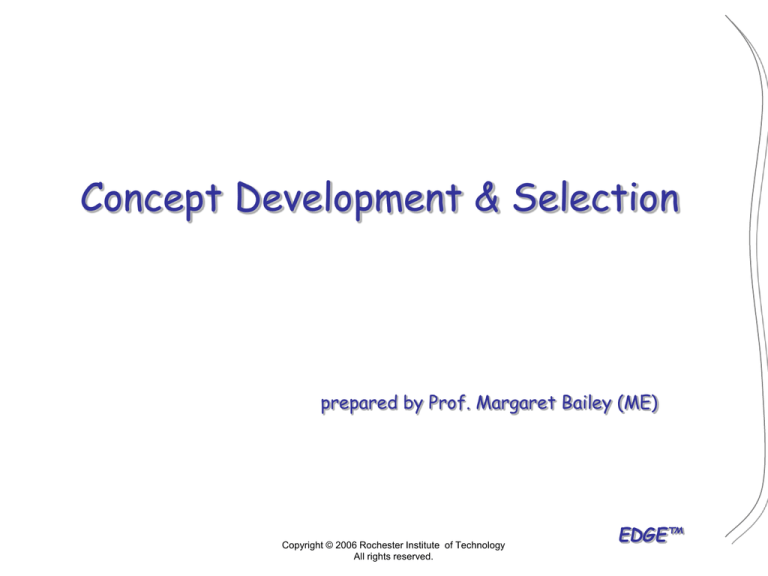
Concept Development & Selection
prepared by Prof. Margaret Bailey (ME)
Copyright © 2006 Rochester Institute of Technology
All rights reserved.
EDGE™
Session Overview
• Introduce Concept Development &
Selection Process
• Explore Two-Stage Methodology
• Demonstrate Above Steps on Example
• Discuss Common Dysfunctions
• Apply Steps to Team SD1 Project
EDGE™
Concept Development & Selection
Session Learning Objectives
1. Understand concept selection matrix - one
of the most widely used decision tools in
product development.
2. Reinforce importance of concept selection
within product development process
3. Expose SD1 students to alternative methods
for selecting product concepts
EDGE™
Concept Development & Selection Process
Mission
Statement
Identify
Customer
Needs
Establish
Target
Specifications
Generate
Product
Concepts
Select
Product
Concept(s)
Test
Product
Concept(s)
Set
Final
Specifications
Plan
Downstream
Development
Perform Economic Analysis
Benchmark Competitive Products
Build and Test Models and Prototypes
Karl T. Ulrich and Steven D. Eppinger, 2004, Product Design and
Development, Exhibit 7-2, Chapter 7, 3rd Edition, Irwin McGraw-Hill
EDGE™
Development
Plan
Concept Development &
Selection Process
Concepts
Scoring
Stage
Selection Criteria
Screening
Stage
Concept Ratings
Winning Concept(s)
Goal: The goal is not to select the best
concept but to develop the best concept
by combining and/or refining
EDGE™
Concept Development & Selection
Funnel
concept generation
concept screening
concept scoring
concept testing
Karl T. Ulrich and Steven D. Eppinger, 2004, Product Design and
Development, Exhibit 7-4, Chapter 7, 3rd Edition, Irwin McGraw-Hill
EDGE™
Concept Selection Process
Screening Stage
Prepare the Matrix
Rate Concepts
Rank Concepts
Combine and Improve
Select Best Concept
Reflect on the Process
Scoring Stage
Prepare the Matrix
Rate Concepts
Rank Concepts
Combine and Improve
Select Best Concept
Reflect on the Process
EDGE™
Concept Selection Example:
Reusable Syringe
Karl T. Ulrich and Steven D. Eppinger, 2004, Product Design and
Development, Exhibit 7-1, Chapter 7, 3rd Edition, Irwin McGraw-Hill
EDGE™
Concept Selection Example:
Reusable Syringe
• Design an improved, reusable syringe with
precise dosage control for outpatient use.
– Current product was too costly and inaccurate
• Seven criteria identified based on stake
holder needs
– Ease of handling, use and manufacture
– Readability of dose settings and accuracy
– Durability and portability
• Refer to Exhibit 7-3 for seven concepts
proposed
EDGE™
Screening Stage
• Prepare the Matrix – Pugh's METHOD
– Criteria
– Select Reference Concept
• Rate Concepts
– Scale (+ – 0)
– Compare to Reference Concepts
• Rank Concepts
• Combine and Improve
– Remove Bad Features
– Combine Good Qualities
Refer to
Textbook
Exhibit 7-5
• Select Best Concepts
– May Be More than One
– Beware of Average Concepts
• Reflect on the Process
– Continuous Improvement
EDGE™
Scoring Stage
•
Prepare the Matrix – Pugh's METHOD
•
Rate Concepts
•
Rank Concepts
•
Combine and Improve
•
Select Best Concepts
•
Reflect on the Process
– Criteria
– Weightings
– Scale (1 - 5)
– Select “Average” Criteria for Reference
– Compare to Reference Criteria
– Sum Weighted Scores
– Remove Bad Features
– Combine Good Qualities
Refer to
Textbook
Exhibit 7-7
– May Be More than One
– Beware of Average Concepts
– Continuous Improvement
EDGE™
Example: Concept Scoring
Concepts
A
(re fere nce)
M as te r Cylinder
DF
E
G+
Le ver Stop
Sw as h Ring
Dial Scre w +
Weight
Rating
Weighted
Score
5%
3
0.15
3
0.15
4
0.2
4
0.2
Ease of Use
15%
3
0.45
4
0.6
4
0.6
3
0.45
Readability of Settings
10%
2
0.2
3
0.3
5
0.5
5
0.5
Dose Metering Accuracy
25%
3
0.75
3
0.75
2
0.5
3
0.75
Durability
15%
2
0.3
5
0.75
4
0.6
3
0.45
Ease of Manuf acture
20%
3
0.6
3
0.6
2
0.4
2
0.4
Portability
10%
3
0.3
3
0.3
3
0.3
3
0.3
Se le ction Crite ria
Ease of Handling
Total Score
Rank
Continue?
Rating
Weighted
Score
Rating
Weighted
Score
Rating
Weighted
Score
2.75
3.45
3.10
3.05
4
1
2
3
No
Develop
No
No
Karl T. Ulrich and Steven D. Eppinger, 2004, Product Design and
Development, Exhibit 7-7, Chapter 7, 3rd Edition, Irwin McGraw-Hill
EDGE™
Tips for Concept Development & Selection
• When possible, use objective rather
subjective criteria
• Useful to identify strengths of concepts that
do not make it through screening/scoring
stages – could these be incorporated on
winning concept(s)?
• Include ease of manufacture or cost as
criteria
• Use concept development & selection process
throughout SD1 and SD2
EDGE™
Practice Concept Development &
Selection on SD1 Project
• Begin Screening Stage based on SD1 Project
Screening Stage
Prepare the Matrix
Rate Concepts
Rank Concepts
Combine and Improve
Select Best Concept
Reflect on the Process
Sample Excel
Spreadsheet
Available for
PUGH!
EDGE™


